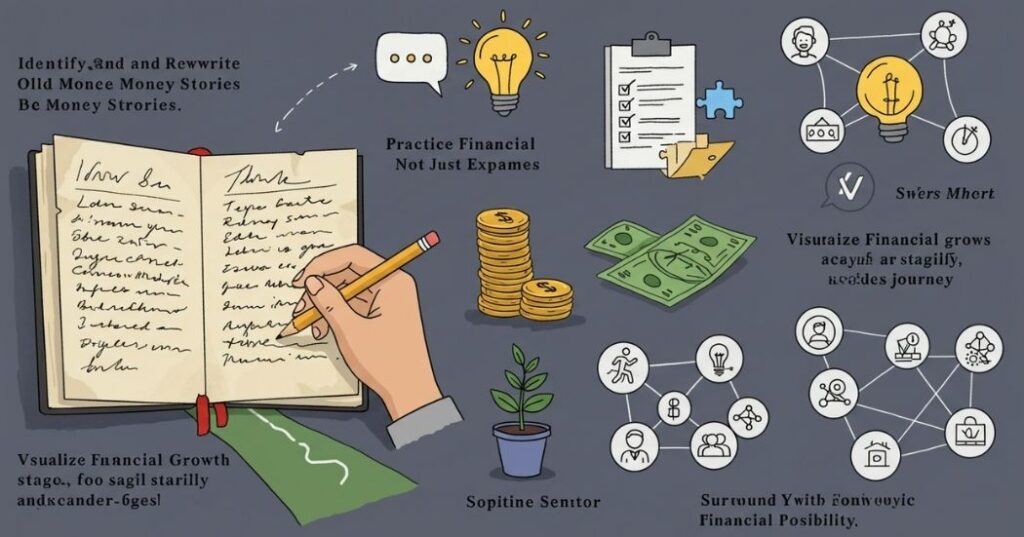Have you ever found yourself caught in a peculiar financial paradox? You earn a decent income, perhaps even more than you once thought possible, yet money always seems to slip through your fingers. Or perhaps you diligently save, but opportunities for growth feel perpetually out of reach. You desire abundance, but deeply ingrained patterns keep you from achieving it.
What if your biggest financial obstacle isn’t a lack of income, a struggling economy, or even a deficit in financial knowledge? What if it’s something far more subtle, yet profoundly powerful: your mindset?
We often carry limiting money beliefs – subconscious assumptions, narratives, and rules we hold about wealth, earning, saving, and spending – that invisibly block us from receiving, growing, or managing our financial resources effectively. These beliefs are rarely conscious; instead, they are deeply rooted in our formative years, shaped by what we observed, what we were told, and the experiences we had within our families and communities. They become the silent architects of our financial realities.
But here’s the transformative truth: these beliefs are not permanent fixtures of your identity. You possess the remarkable capacity to rewire how you think about money, to dismantle old narratives that no longer serve you, and to build a new, empowering financial perspective. And the growth mindset – a concept brilliantly explored by Dr. Carol S. Dweck – is your most potent tool to achieve this profound shift.

What Are Limiting Money Beliefs? The Invisible Financial Walls
Limiting money beliefs are essentially negative or restrictive assumptions you hold about money, wealth, or your ability to generate and manage it. They are often passed down through generations or formed from early life experiences, becoming deeply ingrained filters through which you perceive your financial world. They operate below the surface, influencing your decisions, feelings, and actions around money, often leading to financial self-sabotage, even when your conscious desire is for abundance and prosperity.
Consider if any of these resonate with you:
- “I’ll never be good with money.” This belief cripples your willingness to learn, budget, or invest.
- “Rich people are greedy / mean / unhappy.” This makes you subconsciously push away wealth, fearing it will make you a bad person.
- “Money is the root of all evil.” This creates a moral conflict around financial success.
- “I have to work myself into exhaustion to earn more.” This links effort to suffering, making you resist opportunities for easier, more enjoyable income.
- “There’s never enough money.” This fosters a scarcity mindset, leading to fear-based spending or hoarding.
- “Money doesn’t grow on trees.” While literally true, if applied rigidly, it closes off possibilities for creative income generation.
- “My parents struggled with money, so I will too.” This creates a sense of inherited financial destiny.
These insidious beliefs construct invisible walls around your financial potential. They manifest as procrastination on budgeting, impulsivity with spending, avoidance of investment opportunities, or even self-sabotage when financial success begins to materialize. As financial psychologists Dr. Brad Klontz and Dr. Ted Klontz explain in Mind Over Money, these “money disorders” are deeply rooted in our unconscious financial scripts, often leading to self-defeating behaviors [5].
How a Growth Mindset Changes Your Financial Story
Enter the growth mindset. Pioneered by Stanford psychologist Dr. Carol S. Dweck, a growth mindset is the fundamental belief that your basic abilities, intelligence, and even your personality traits are not fixed endowments, but rather qualities that can be developed and cultivated through dedication and hard work [1]. Applied to finances, this means you stop viewing your financial aptitude as an immutable trait you either possess or lack.
Instead, a growth mindset helps you:
- Learn from financial mistakes, rather than fearing them: Instead of viewing a bad investment or a budgeting misstep as proof of your financial incompetence, you see it as valuable data for learning and improvement.
- Seek advice and mentorship, instead of avoiding it: If you believe you can learn, asking for help from financial experts or mentors becomes an act of strength and wisdom, not an admission of weakness.
- Build confidence in money management through practice: You understand that financial literacy is a skill, honed through consistent effort, learning, and application, much like learning a new language or musical instrument.
You stop seeing your relationship with money as something fixed (“I’m inherently bad at budgeting” or “I’ll always be poor”) and instead start seeing it as something learnable and adaptable (“I can figure this out with help, practice, and new strategies”). This fundamental shift opens your mind to possibilities, resilience, and consistent improvement.
5 Growth Mindset Tools to Rewire Limiting Money Beliefs

Rewiring deeply ingrained beliefs isn’t an overnight process, but it is entirely possible with consistent, intentional effort. Here are five powerful growth mindset tools to help you reshape your financial narrative:
1. Identify and Rewrite Old Money Stories: Unearthing Your Financial Blueprint
Our current financial behaviors are often a direct reflection of the “money stories” we absorbed during childhood. These stories are the narratives, rules, and beliefs we internalized about money, wealth, poverty, and earning from our parents, family, and wider community. They might be explicit statements (“Money doesn’t buy happiness”) or implicit observations (witnessing constant financial stress or extreme frugality).
Journal Prompt: “What was I explicitly taught about money growing up? What did I observe about money and wealth in my family and community? What were the unspoken rules around money?”
Then ask: “Does this belief truly serve the life I want to create today? Does it align with my vision for financial peace and abundance?”
Why this works: Awareness is the absolutely essential first step in changing your financial narrative. You cannot rewrite a script you don’t even know exists. By bringing these unconscious beliefs to the surface through journaling, you gain the power to consciously examine them, challenge their validity, and begin the process of constructing a more empowering narrative that aligns with your financial aspirations. This act of self-reflection helps you break free from inherited limitations and consciously choose new financial beliefs.
2. Practice Financial Reframes: Shifting from Scarcity to Possibility
A scarcity mindset, often fueled by limiting beliefs, automatically defaults to “I can’t” or “There isn’t enough.” This closes off cognitive pathways to solutions and opportunities. Financial reframing is the active practice of challenging these immediate, limiting thoughts and consciously seeking alternative, growth-oriented perspectives.
When you catch a limiting thought like “I can’t afford that” (which often signals a desire, not an absolute impossibility), instead of accepting it as final, try:
- “How could I afford that if it truly adds value to my life and aligns with my goals? What creative solutions exist?”
- “What value would this (investment, purchase, experience) truly add to my life, beyond just its cost? Is it an expense or an investment in my growth?”
Why this works: This intentional cognitive shift opens your brain to possibility, problem-solving, and resourcefulness. It moves you from a fixed, “either/or” mentality to a growth-oriented, “how might I?” approach. This practice actively trains your brain to seek solutions rather than dwelling on limitations, a core tenet of a growth mindset [1].
3. Track Wins, Not Just Expenses: Celebrating Your Financial Progress
Many people obsessively track their expenses, which is a crucial part of budgeting. However, they often neglect to acknowledge and celebrate their financial “wins.” This creates a negative feedback loop where money management feels like a constant struggle, only highlighting what’s going wrong.
We often obsess over what we spent—but what about what you managed, saved, or negotiated?
Tip: Keep a “money wins” list each week. This can be in a dedicated journal, a simple note on your phone, or a section in your budget spreadsheet.
Examples of money wins:
- “Successfully negotiated a bill down by $50.”
- “Resisted an impulse spend on something I didn’t truly need.”
- “Saved 5% of my income this pay period, hitting my savings goal.”
- “Paid off an extra $100 on my credit card.”
- “Discovered a new strategy to reduce recurring expenses.”
- “Learned a new investment term or concept.”
- “Had an honest conversation about money with my partner.”
Why this works: Celebrating small financial successes triggers the release of dopamine, a neurotransmitter associated with reward and motivation. This creates a positive feedback loop, training your brain to associate money management with feelings of accomplishment and satisfaction. This positive reinforcement makes you more likely to repeat the desired financial behaviors, building momentum and confidence, as explored by authors like Ramit Sethi in I Will Teach You You to Be Rich [2].
4. Visualize Financial Growth as a Journey: Embracing Patience and Progress
Limiting beliefs often fixate on the current financial reality, leading to feelings of being “stuck” or “behind.” This creates immense pressure and discouragement, making the long-term journey of wealth building seem impossible.
Instead of constantly thinking “I’m so behind” or “I’ll never catch up,” actively visualize your financial growth as a dynamic journey of continuous learning and progress.
Visualize where you’re going, not just where you are:
- “I’m on a path to continuously learning how to earn, manage, and grow my resources wisely, one step at a time.”
- “I am consistently building my financial knowledge and capabilities.”
- “Every wise financial decision I make is moving me forward on my unique path to abundance.”
Why this works: Visualization is a powerful tool for programming your subconscious mind. By consistently picturing yourself on a path of growth and learning, you reinforce a growth mindset and reduce the pressure of immediate outcomes. You shift your focus from past perceived failures to future potential and ongoing progress. Wealth building is a marathon, not a sprint, and this mindset helps anchor your progress, not just immediate financial results, as discussed by experts like Tony Robbins in Money: Master the Game [3].
5. Surround Yourself with Financial Possibility: Curating Your Influences
Your environment, including your information diet and the people you interact with, profoundly shapes your beliefs and mindset. If you constantly consume content or interact with individuals who perpetuate scarcity, fear, or negativity around money, it reinforces your own limiting beliefs.
Who you learn from matters. To cultivate a growth-oriented money mindset, consciously curate your influences.
Surround yourself with financial possibility:
- Follow creators and podcasts who speak from abundance, not fear: Seek out financial educators, thought leaders, and content creators who emphasize growth, learning, and proactive strategies rather than fear-mongering or scarcity.
- Try: Afford Anything (Paula Pant), The Budgetnista (Tiffany Aliche) [4], or Ramit Sethi (I Will Teach You To Be Rich).
- Seek out mentors: Find individuals who have achieved financial success or mastery in areas you aspire to grow in. Learn from their approaches, their mindset, and their resilience in overcoming challenges.
- Engage in positive financial conversations: Seek out communities or friends who discuss money openly, constructively, and with a growth-oriented perspective.
Why this works: Exposure to positive financial narratives and role models helps to normalize growth, demystify wealth, and provide tangible examples of what’s possible. It helps to dismantle the unconscious belief that “people like me” cannot achieve financial success, expanding your own perception of financial possibility.
Real-Life Shift: Maria’s Story—A Testament to Mindset Change
Maria, a client I once worked with, always carried the unspoken belief that “people like her”—those from humble beginnings without inherited wealth—couldn’t build significant financial security. This limiting money belief manifested as a constant undercurrent of anxiety, procrastination around financial planning, and a tendency to spend impulsively whenever extra money came in, as if to prove her subconscious belief that “it would just disappear anyway.”
Through consistent coaching and the dedicated practice of journaling her old money stories, Maria began to unearth the deeply rooted narratives she had absorbed from her childhood. She consciously identified these beliefs and then diligently worked to reframe them. Instead of “I’ll always struggle with money,” she started affirming, “I am open to learning and creating new financial possibilities.”
This mindset shift wasn’t instant, but it was profound. Within six months, Maria, armed with her reframed beliefs and a newfound sense of agency, built a side hustle around her passion for digital art. Starting with a modest $150 investment in online courses, she systematically applied a growth mindset to learning new skills, marketing her services, and managing her finances. Within a year, that side hustle consistently brought in an additional $2,000 per month, completely transforming her financial outlook and her self-perception. Maria’s story is a powerful testament to the fact that internal shifts precede external abundance.
Affirmations for a Growth-Oriented Money Mindset: Daily Reinforcement
Affirmations are positive, declarative statements that, when repeated consistently, can help to reprogram your subconscious mind and reinforce new beliefs. They are particularly powerful for overcoming limiting money beliefs.
- “I am open to learning new ways to earn and save.” (Counters: “I’ll never understand money.”)
- “I can make mistakes and still build wealth.” (Counters: “One mistake ruins everything.”)
- “I deserve financial peace and abundance.” (Counters: “I’m not worthy of wealth.”)
- “Money flows to me easily and consistently.” (Counters: “Money is hard to get.”)
- “I am a skilled and capable money manager.” (Counters: “I’m bad with budgeting.”)
Say them daily – especially when self-doubt hits, when you’re facing a financial decision, or when an old limiting belief resurfaces. Consistency is key to their effectiveness.
Final Thoughts: Your Financial Story is Yours to Rewrite
You weren’t born with your beliefs about money—you inherited them, absorbed them from your environment, or formed them from past experiences. And that profound realization means you possess the inherent power to change them.
A growth mindset won’t magically make you rich overnight, nor does it promise an absence of financial challenges. But it will fundamentally shift your relationship with money, making you ready to grow, learn, earn, manage, and receive in entirely new, empowered ways. It equips you with the resilience, creativity, and adaptability necessary to navigate the financial world with confidence.
Want to truly rewire your money beliefs and unlock your full financial potential? Begin by recognizing the power of your mindset. Our mindset coaching and digital money workbook offer structured support to help you reset your financial narratives and reclaim your financial power.
Related Reading: From Scarcity to Abundance: Practical Exercises to Shift Your Mindset (This would be an internal link to a relevant article on your site)
📚 References
- Sethi, R. (2019). I Will Teach You to Be Rich (2nd Edition). Available on Amazon: https://www.amazon.com/dp/1523505745
- Robbins, T. (2014). Money: Master the Game. Available on Amazon: https://www.amazon.com/dp/1476757801

